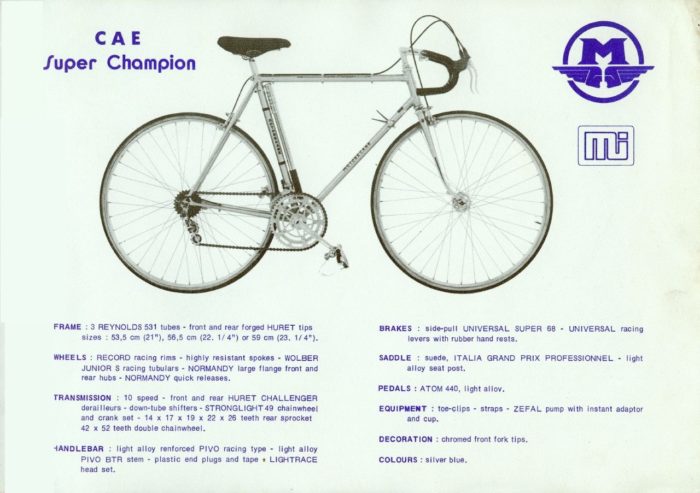Some time ago I acquired a Motobecane Super Champion frame for no better reason than that I wanted a Wagner fork crown and some metric Reynolds 531 frame tubing. The need for the fork crown went away and I decided not to dismantle the frame for the tubes which led to a decision to build up the frame into a bicycle. So started my research into what would be the appropriate parts to build it close to factory specification.
Catalogues
Searching the internet I found very little information on the model. I also found a number of inquiries by other people looking for information, and not getting much in reply. There really is very little available.
The only catalogue information I have found so far is in a UK Motobecane catalogue for 1975 . The lack of catalogue information, and of information generally, would indicate that this was a very short-lived model only made for a year, or two at the most. The general consensus seems to be to date these bikes 1975, which is also the year of the UK catalogue. I don’t necessarily put much faith in the dates people put on their bikes, but the one in the UK is substantiated by the 1975 catalogue with the same specification.
Specifications
All the bikes I can find on the internet that seem to be at or near original specification have a frame with the three main tubes Reynolds 531 butted tubing (tubes renforcees), half chrome front forks, Stronglight 49D cranksets and Huret Challenger gears, Pivo bars and stem, with the exception of one bike in the US, supposedly purchased in Europe, that carries the model name on the top tube, but that is unquestionably a Team Champion (https://www.thebeautifulbicycle.com/2017/06/1973-motobecane-super-champion/) . It is an anomaly that might be explained by anything from human error to a factory tryout.
Below I give the links to a few bikes I have found on the internet, that appear to be substantially original, with comments on their specification:
Motobecane Super Champion 1975 | Discovered in a closed down… | Flickr I have placed this first because it is pristine and original and its specification matches the UK catalogue. The interesting things I note are: metal head badge; Wagner cast fork crown; “Made in France” down tube decal indicates made for an export market. Universal mod.68 brakes.

Motobecane Super Competition Vintage Road Bike Restore (thevelocollective.com). This again appears to be quite original. Differences from the above are plastic head badge, pressed steel fork crown, no “Made in France”, Weinmann centre-pull brakes.
Motobecane Super Champion 1975 – The Velo Collective. Very similar to the one immediately above.
https://obancycles.fr/portfolio/super-champion. This is restored and likely some parts substitutions, but Wagner cast fork crown and plastic head badge likely original, Dia-Compe side-pull brakes.
http://bibibikestock.blogspot.com/p/reference-reference-85us20-brand-marque.html. Very similar to the immediately above except more original equipment. It has Dia-Compe brakes too, so maybe these were original spec for some production batches or markets.
The bike pictured here is in the UK and is/was on eBay. It is interesting in being similar spec to the UK bike listed above, except it has orange paint and a stamped steel fork crown instead of cast and 3ttt bars and stem unlike any other I have seen. It is a bit of a wreck unfortunately, otherwise I might have been interested.

I did find a few more bikes on Facebook in the group “Vintage Motobecane Bicycle Enthusiasts”, but there is really not much more to learn. The bikes with as stamped for crown tended to have Weinmann center-pull brakes and bikes with a cast fork crown tended to have Dia-Compe Gran Compe brakes, with the exception of the two bikes I found in the UK that both had Universal Super 68 brakes regardless of the fork crown.
From this small sample size, I deduce that whether a bike has a stamped or cast fork crown is pot luck – there is not enough to see a pattern; metal head badge and “Made in France” limited to UK (and other export?) market; brakes depend on market or production batch or both.
Model Name
My thoughts about the short-lived model name are that Super Champion, the company that made excellent Super Champion rims, asked Motobecane to cease and desist using their name for a bicycle and that Motobecane agreed. But this is only conjecture. There is no record on the internet of a court case that I can find, so if it was an issue, it was probably settled amicably. Super Champion would be an excellent name for a Motobecane racing bike to go alongside Team Champion and Le Champion. But it was not to be for very long.
Make no mistake, this is a bona fide racing bike with appropriate frame geometry, racing gears, tubular tires and fairly lightweight. And in orange paint it is not too far different in looks from the top of the line Team Champion. Certainly more of an entry level race bike, but a competitor would be scarcely disadvantaged relative to a rider mounted on a Team Champion.
